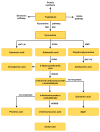Microbiota, Tryptophan and Aryl Hydrocarbon Receptors as the Target Triad in Parkinson's Disease-A Narrative Review
- PMID: 38474162
- PMCID: PMC10931713
- DOI: 10.3390/ijms25052915
Microbiota, Tryptophan and Aryl Hydrocarbon Receptors as the Target Triad in Parkinson's Disease-A Narrative Review
Abstract
In the era of a steadily increasing lifespan, neurodegenerative diseases among the elderly present a significant therapeutic and socio-economic challenge. A properly balanced diet and microbiome diversity have been receiving increasing attention as targets for therapeutic interventions in neurodegeneration. Microbiota may affect cognitive function, neuronal survival and death, and gut dysbiosis was identified in Parkinson's disease (PD). Tryptophan (Trp), an essential amino acid, is degraded by microbiota and hosts numerous compounds with immune- and neuromodulating properties. This broad narrative review presents data supporting the concept that microbiota, the Trp-kynurenine (KYN) pathway and aryl hydrocarbon receptors (AhRs) form a triad involved in PD. A disturbed gut-brain axis allows the bidirectional spread of pro-inflammatory molecules and α-synuclein, which may contribute to the development/progression of the disease. We suggest that the peripheral levels of kynurenines and AhR ligands are strongly linked to the Trp metabolism in the gut and should be studied together with the composition of the microbiota. Such an approach can clearly delineate the sub-populations of PD patients manifesting with a disturbed microbiota-Trp-KYN-brain triad, who would benefit from modifications in the Trp metabolism. Analyses of the microbiome, Trp-KYN pathway metabolites and AhR signaling may shed light on the mechanisms of intestinal distress and identify new targets for the diagnosis and treatment in early-stage PD. Therapeutic interventions based on the combination of a well-defined food regimen, Trp and probiotics seem of potential benefit and require further experimental and clinical research.
Keywords: Parkinson’s disease; aging; aryl hydrocarbon receptor; diet; individualized therapy; kynurenine; microbial–intestinal–brain axis; microbiota; probiotics; tryptophan.
Conflict of interest statement
The authors declare no conflicts of interest.
Figures



Similar articles
-
Activation of aryl hydrocarbon receptor (AhR) in Alzheimer's disease: role of tryptophan metabolites generated by gut host-microbiota.J Mol Med (Berl). 2023 Mar;101(3):201-222. doi: 10.1007/s00109-023-02289-5. Epub 2023 Feb 9. J Mol Med (Berl). 2023. PMID: 36757399 Free PMC article. Review.
-
Gut Microbiota Regulation of AHR Signaling in Liver Disease.Biomolecules. 2022 Sep 6;12(9):1244. doi: 10.3390/biom12091244. Biomolecules. 2022. PMID: 36139083 Free PMC article. Review.
-
Burn-Induced Gut Microbiota Dysbiosis Aggravates Skeletal Muscle Atrophy by Tryptophan-Kynurenine Mediated AHR Pathway Activation.Adv Sci (Weinh). 2025 Apr;12(14):e2409296. doi: 10.1002/advs.202409296. Epub 2025 Feb 14. Adv Sci (Weinh). 2025. PMID: 39950940 Free PMC article.
-
Impact of the Gut Microbiota on Intestinal Immunity Mediated by Tryptophan Metabolism.Front Cell Infect Microbiol. 2018 Feb 6;8:13. doi: 10.3389/fcimb.2018.00013. eCollection 2018. Front Cell Infect Microbiol. 2018. PMID: 29468141 Free PMC article. Review.
-
Involvement of the microbiota-gut-brain axis in chronic restraint stress: disturbances of the kynurenine metabolic pathway in both the gut and brain.Gut Microbes. 2021 Jan-Dec;13(1):1-16. doi: 10.1080/19490976.2020.1869501. Gut Microbes. 2021. PMID: 33535879 Free PMC article.
Cited by
-
Human and gut microbiota synergy in a metabolically active superorganism: a cardiovascular perspective.Front Cardiovasc Med. 2024 Oct 11;11:1411306. doi: 10.3389/fcvm.2024.1411306. eCollection 2024. Front Cardiovasc Med. 2024. PMID: 39465131 Free PMC article. Review.
-
Psychobiotics and the Microbiota-Gut-Brain Axis: Where Do We Go from Here?Microorganisms. 2024 Mar 22;12(4):634. doi: 10.3390/microorganisms12040634. Microorganisms. 2024. PMID: 38674579 Free PMC article. Review.
-
Tryptophan metabolism-related gene CYP1B1 serves as a shared biomarker for both Parkinson's disease and insomnia.Sci Rep. 2025 Jan 8;15(1):1362. doi: 10.1038/s41598-024-84362-8. Sci Rep. 2025. PMID: 39779759 Free PMC article.
-
The GPR39 Receptor Plays an Important Role in the Pathogenesis of Overactive Bladder and Corticosterone-Induced Depression.Int J Mol Sci. 2024 Nov 25;25(23):12630. doi: 10.3390/ijms252312630. Int J Mol Sci. 2024. PMID: 39684342 Free PMC article.
-
Kynurenine Pathway after Kidney Transplantation: Friend or Foe?Int J Mol Sci. 2024 Sep 14;25(18):9940. doi: 10.3390/ijms25189940. Int J Mol Sci. 2024. PMID: 39337426 Free PMC article. Review.
References
-
- Nalls M.A., Blauwendraat C., Vallerga C.L., Heilbron K., Bandres-Ciga S., Chang D., Tan M., Kia D.A., Noyce A.J., Xue A., et al. Identification of Novel Risk Loci, Causal Insights, and Heritable Risk for Parkinson’s Disease: A Meta-Genome Wide Association Study. Lancet Neurol. 2019;18:1091–1102. doi: 10.1016/S1474-4422(19)30320-5. - DOI - PMC - PubMed
Publication types
MeSH terms
Substances
Grants and funding
LinkOut - more resources
Full Text Sources
Medical

